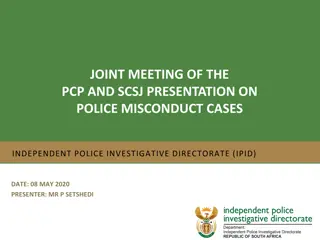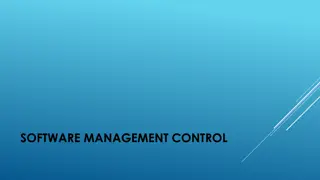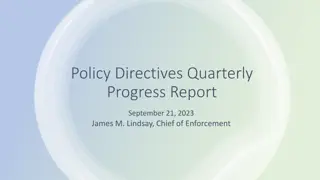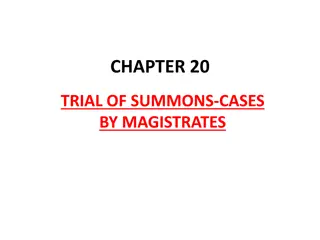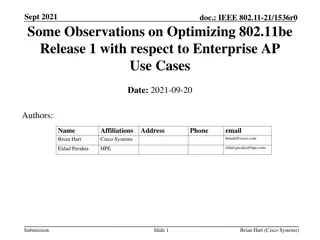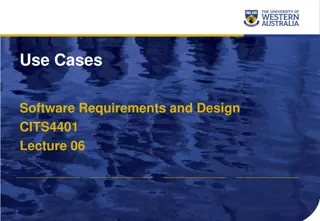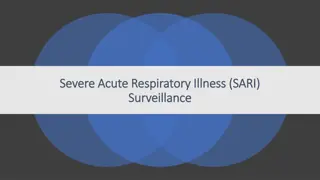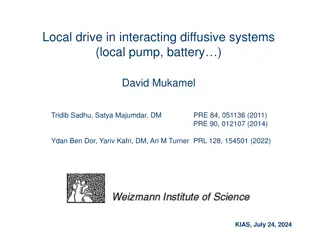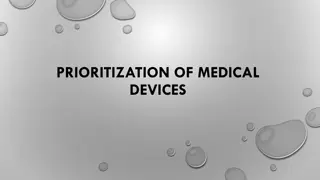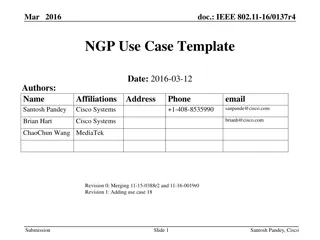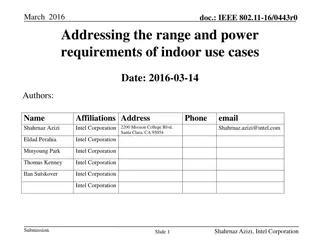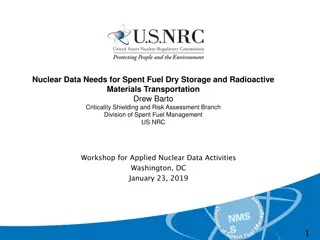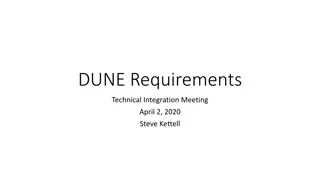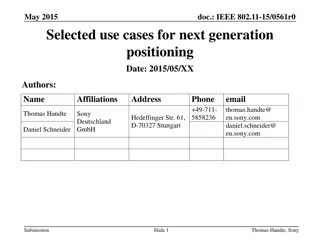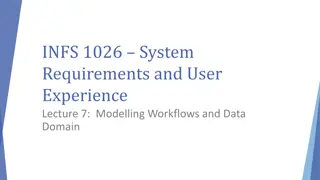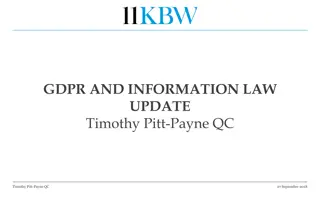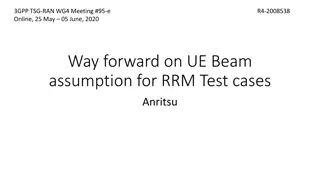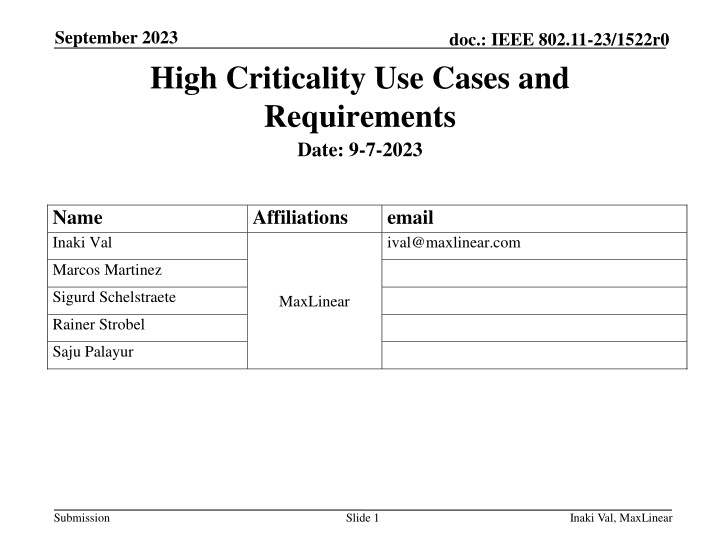
IEEE 802.11-23/1522r0: Understanding Network Traffic Patterns and Criticality
Explore the classification and requirements of traffic in an 802.11 network, focusing on high criticality use cases and features. Learn about different application layer features targeting packet delivery improvement and reduced latency. Evaluate proposed features in the context of final applications for enhanced network reliability.
Download Presentation

Please find below an Image/Link to download the presentation.
The content on the website is provided AS IS for your information and personal use only. It may not be sold, licensed, or shared on other websites without obtaining consent from the author. If you encounter any issues during the download, it is possible that the publisher has removed the file from their server.
You are allowed to download the files provided on this website for personal or commercial use, subject to the condition that they are used lawfully. All files are the property of their respective owners.
The content on the website is provided AS IS for your information and personal use only. It may not be sold, licensed, or shared on other websites without obtaining consent from the author.
E N D
Presentation Transcript
September 2023 doc.: IEEE 802.11-23/1522r0 High Criticality Use Cases and Requirements Date: 9-7-2023 Name Inaki Val Affiliations email ival@maxlinear.com Marcos Martinez Sigurd Schelstraete MaxLinear Rainer Strobel Saju Palayur Submission Slide 1 Inaki Val, MaxLinear
September 2023 doc.: IEEE 802.11-23/1522r0 Goals Discuss the classification and requirements of the traffic found in an 802.11 network Identify the 802.11 features needed depending on traffic requirements and characteristics Submission Slide 2 Inaki Val, MaxLinear
September 2023 doc.: IEEE 802.11-23/1522r0 Introduction UHR targets the improvement of packet delivery by reducing the transmission latency and enhancing network reliability [1] Previous contributions have presented different UHR features depending on the nature of the traffic in the application layer [2] Other contributions have focused on the low latency features for fast delivery of the data frames (i.e., preemption) [3] Low latency applications have also been linked to Real- Time Applications (RTA) [4] Submission Slide 3 Inaki Val, MaxLinear
September 2023 doc.: IEEE 802.11-23/1522r0 Problem Statement Many new features are being proposed in the context of UHR These features need to be evaluated and understood in the context of the final application In this contribution we classify different network applications and identify their needs, to select the features that may apply Submission Slide 4 Inaki Val, MaxLinear
September 2023 doc.: IEEE 802.11-23/1522r0 Network Traffic Pattern One way to classify Network traffic patterns is according to inter-arrival time between burst packets Periodic pattern, having a nearly predictable behavior Non-periodic (or aperiodic) pattern, based on random external events Exact frame transmission impossible to predict Submission Slide 5 Inaki Val, MaxLinear
September 2023 doc.: IEEE 802.11-23/1522r0 Network Traffic Criticality Network Traffic can also be classified as low or high criticality (a measure of reliability and latency) High critical data must be reliably delivered to the destination within a known time window (time latency) Latency value depends on the application, therefore we should talk about bounded latency requirement Low critical data has more relaxed requirements Sporadic communication errors do not imply an application malfunction Submission Slide 6 Inaki Val, MaxLinear
September 2023 doc.: IEEE 802.11-23/1522r0 Application Matrix Based on the previous criteria, we build the following matrix Periodicity Periodic / Low Critical Aperiodic / Low Critical Applications: video streaming, IoT devices (home appliances) Applications: web browsing, chat, mobile applications, IoT devices (home appliances) Already covered by 802.11 Criticality Periodic / High Critical Aperiodic / High Critical Bounded latency applications: VR/AR, real-time video, gaming, video streaming over TCP/IP, industrial IoT (Factory Automation), home surveillance, cloud-based applications, medical equipment Critical events applications: safety alarms, industrial IoT (Process Automation), medical equipment Objective of the PAR Submission Slide 7 Inaki Val, MaxLinear
September 2023 doc.: IEEE 802.11-23/1522r0 Low Criticality Applications Current 802.11 features usually provide enough performance (throughput, reliability, latency) for good functionality of the network services Improvements in OBSS interference mitigation will help increase the availability of the communication link Periodic traffic applications: Video streaming, Smart Home IoT devices (several seconds of periodicity) [5] Event-driven (aperiodic) applications: web browsing, chat, mobile applications, Smart Home IoT devices Limited effort needed in UHR, focused on improvement in OBSS interference scenarios Submission Slide 8 Inaki Val, MaxLinear
September 2023 doc.: IEEE 802.11-23/1522r0 Periodic and High Critical Applications with real-time (RTA) traffic requirements [6,7,8] Closed-loop communication (downlink and uplink sequence) Constant update rate (periodic communication) High reliability and Bounded latency (value depends on the application) Applications: VR/AR, real-time video, gaming, industrial IoT, home security, Smart Home IoT, cloud-based applications Applications covered in the 802.24 whitepaper about low latency [7] Bounded latency in the range of 1 to 20 milliseconds [6,7,9] Throughput in the range of 1 to 400 Mbps [6,7,9] Deterministic scheduling features are needed for the strict control of the QoS for the traffic streams in DL and UL communication In summary, this is the case where UHR needs to focus Submission Slide 9 Inaki Val, MaxLinear
September 2023 doc.: IEEE 802.11-23/1522r0 Aperiodic and High Critical Applications that generate random events, where the data must arrive at the destination reliably due to its critical data Applications: safety alarms, critical monitoring sensors, safety systems, etc. (e.g., home security system events have a response time under 15 seconds) For industrial applications, data needs to be delivered within a bounded latency, in the range of 50 to 100 milliseconds, depending on the application [7, 10] Reliability is a key requirement, being more critical than meeting the latency, which could not be that challenging to accomplish with the current 802.11 technology These cases require features that focus on reliability rather than low latency Submission Slide 10 Inaki Val, MaxLinear
April 2023 doc.: IEEE 802.11-23/1522r0 Reliability vs. Low Latency Aperiodic and High Critical data delivery appears to require reliability more than it requires very low latency Within the categorization presented earlier, we see no applications that are both non-periodic and very low latency (< 5 msec) The various forms of preemption [3,13-16] appear to be tailored towards non-periodic and very low latency applications Does this solve real-world problem? Should solution focus on periodic traffic instead? Submission Slide 11 Inaki Val, MaxLinear
September 2023 doc.: IEEE 802.11-23/1522r0 Summary Low Limited effort needed, focused on improvement in OBSS interference scenarios Criticality Many contributions have proposed features for improving these use cases [8,12,13], mainly for optimizing the transaction scheduling to lower the latency within the bound limits Scheduling for RTA Multi-AP (repeater/mesh) topologies scheduling OBSS interference mitigation High Critical and Periodic Attending to the previous requisites, this use case is not necessarily about low latency, but reliability is mandatory Bounded latency (50 100ms) Application frame tagging Specific modulation/coding for increased reliability High Critical and Aperiodic Submission Slide 12 Inaki Val, MaxLinear
September 2023 doc.: IEEE 802.11-23/1522r0 Conclusion We have identified the high criticality (reliability and bounded latency) use cases as one of the main focus of UHR, attending to the PAR We question whether any non-periodic traffic requires very low latency (< 5 msec) Note that reliability remains a key requirement High criticality applications that follow periodic traffic patterns need special attention to provide them with adequate features Submission Slide 13 Inaki Val, MaxLinear
September 2023 doc.: IEEE 802.11-23/1522r0 References [1] IEEE 802.11-23/0028r6 UHR PAR discussion [2] Serhat Erkucuk and et al. (Offino), Enhanced Scheduling Method for Low Latency Traffic , 23/0378r0, May 2023. [3] Juan Fang and et al. (Intel), Preemption for Low Latency Application , 23/0092r0, March 2023. [4] Peshal Nayak and et al. (Samsung), QoS Enhancements for Next Generation Wi-Fi Networks 23/1207r0, July 2023. [5] Nguyen-An H, Silverston T, Yamazaki T, Miyoshi T. IoT Traffic: Modeling and Measurement Experiments. IoT. 2021; 2(1):140-162. https://doi.org/10.3390/iot2010008 [6] Kate Meng and et al. (Tencent Technology), RTA report summary , 19/0065r6, March 2019. [7] Oliver Holland and et al. Low Latency Communication White Paper , P802.24-23-0010r4, July 2023. [8] Dmitry Akhmetov and et al. (Intel), Medium efficient scheduled channel access in next generation 802.11 , 23/0936r0, July 2023. [9] M. Mainuddin and et al., "IoT Device Identification Based on Network Traffic Characteristics," IEEE GLOBECOM 2022, Rio de Janeiro, Brazil, 2022, pp. 6067-6072, doi: 10.1109/GLOBECOM48099.2022.10001639 Submission Slide 14 Inaki Val, MaxLinear
September 2023 doc.: IEEE 802.11-23/1522r0 References [10] Karl Montgomery et al., Wireless User Requirements for the Factory Workcell , NIST Advanced Manufacturing Series 300-8 (Rev. 1), doi: https://doi.org/10.6028/NIST.AMS.300- 8r1/upd [11] Kazi Huq and et al. (Ofinno), Enhanced Trigger-Based Uplink Transmission , 22/1923r1, November 2022. [12] Dmitry Akhmetov and et al. (Intel), Challenges to achieve deterministic low latency in next generation 802.11 , 22/1926r0, November 2022. [13] Kiseon Ryu and et al. (NXP), TXOP preemption follow up , 23/1174r0, July 2023. [14] Daniel Verenzuela and et al. (Sony), Overlapped indication to support preemption , 23/1194r0, July 2023. [15] Juan Fang and et al. (Intel), Preemption for low latency application (Follow up) , 23/1229r1, August 2023. [16] Juseong Moon and et al. (KNUT), Considerations on Inter-PPDU based Preemption Scheme , 23/1242r1, August 2023. Submission Slide 15 Inaki Val, MaxLinear

